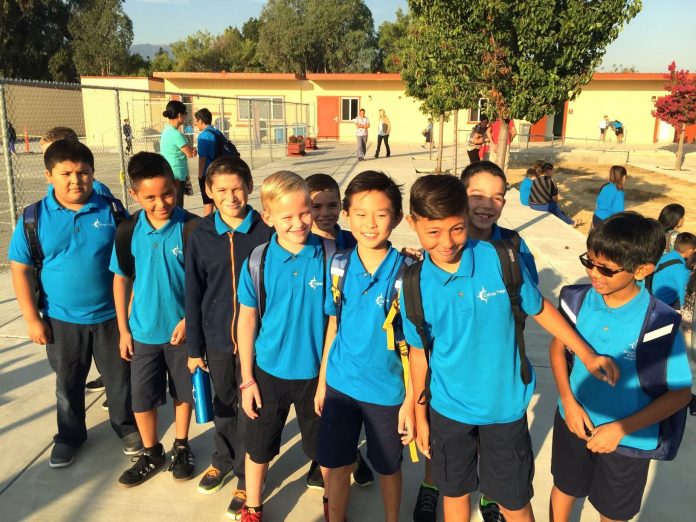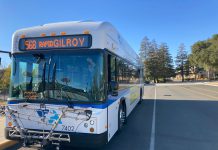
GILROY—It’s another school term for Gilroy, but for one of its school it’s a milestone year.
Gilroy Prep School officially moved this week from the ranks of elementary education to the heady air of middle school-dom, adding sixth grade instruction with a full compliment of 60 students, two teachers, classroom assistants, high-tech teaching tools and an academic pedigree known around the world.
The city’s only charter school, GPS’s academic successes have pretty much astounded observers since its start in 2011 with three grades, K-2. It has added a grade each year since.
Under the leadership of James Dent, who heads the school’s management organization, Navigator Schools, the charter’s no-nonsense approach to teaching and a dramatic improvement in test scores have attracted a long line of visiting education professionals seeking the GPS elixir of learning.
They have come from England, Japan and Korea. Delegations from at least ten U.S. states, including New York, have toured the school. And in October, 40 principals from Chicago will watch and learn from a system that Dent says studies other schools as much as it is studied.
Visitors want to know how Dent and his small staff get kids to learn so much so quickly, at rates that astonish parents, who in turn are devoted to the school.
The school makes a point of helping low-income students from non-English speaking homes, but its population pretty much mirrors the district’s demographic profile.
As a public school charter, it has its own governing board, but finances and student performance are monitored by the Gilroy Unified School District, from which it draws its funding.
Entrance to GPS is by lottery; the waiting list is 780 names long.
Here, in part, is why: in recent tests, GPS students far exceeded their counterparts statewide in math and English Language Arts proficiency, 90 percent compared to 58 percent. GPS outscored state figures by at least 30 percentage points in each category.
In terms of API scores, Navigator’s Latino students are 172 points ahead of those in the state; white students are ahead by 82 points; and English language learners by 190 points. Among students in socio-economically disadvantaged groups, Navigator students outscored the state average by 178 points.
Dent says the school is always evolving, always looking for ways to improve. Right now, he said, “Our number one mission is to develop top-tier teachers and principals (because) they will drive student achievement.”
The school has a very low teacher-to-student ratio (for part of the day, it’s 10-to-1), and teaching assistants and volunteers work constantly with individuals or small groups. Students are continually reinforced and learn to see and correct mistakes immediately.
Underpinning whole system is the robust use of iPads and other technologies that are as much a part of the GPS experience as a pencil and pad were for generations before.
And students move from one subject or project to another quickly—20 minutes here, 25 minutes there—to keep them engaged and thinking.
“The days are broken into smaller chunks, they don’t have the opportunity to become disengaged,” said Kristen Carr, Navigator’s director of community outreach.
In the course of a day, each student might work with four to six adults, she said.
The system, said Dent, “is so engaging to students and so effective at driving achievement to another level.” Navigator’s use of technology, he said, “amplifies learning.”
The other part, the other key, according to Dent and Carr, is that students are not the only ones who come to GPS to be taught and to learn—it’s just as much a school for teachers and administrators as it is for students.
To that end, the “teaching-coaching model” is used, according to Carr.
“It’s the real deal,” said Dent. “It’s how you get strength and consistency.”
Teachers in training rotate from classroom to classroom, collaboration is continuous; teachers are videotaped and their work is critiqued at least once a week, compared to once a year in other district schools, with the goal of constant improvement and advancement.
But whether it’s a newbie kindergartener or a freshly minted sixth-grader breaking new ground at GPS, students are at the heart of the mission, all of them.
As Carr puts it, “Our focus is closing the achievement gap and we take no excuses for why that does not happen.”













How to contact current (2024) principal to send along my article on cooperative learning, with students teaching others. Thank you,
Diane Bridgeman, Ph.D.